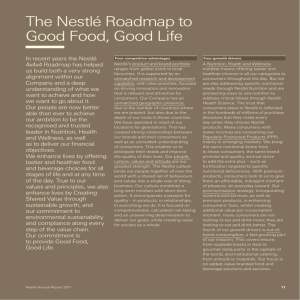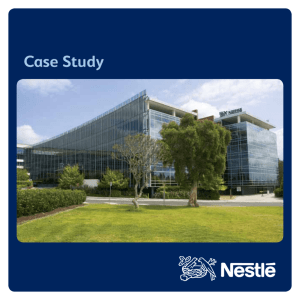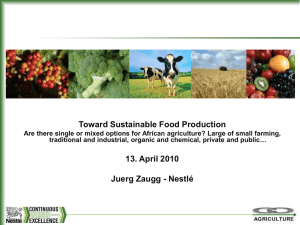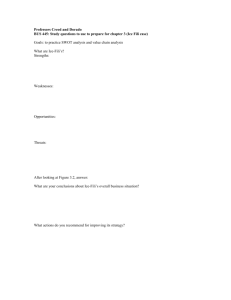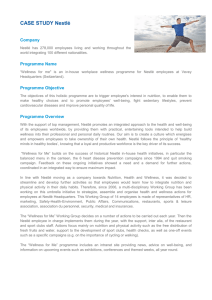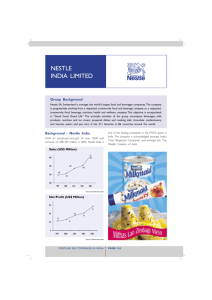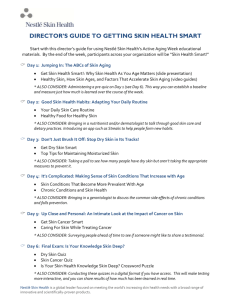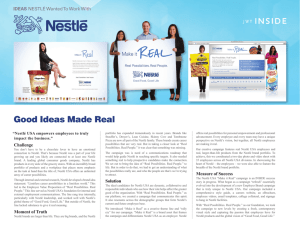Focus on Export Audit
advertisement
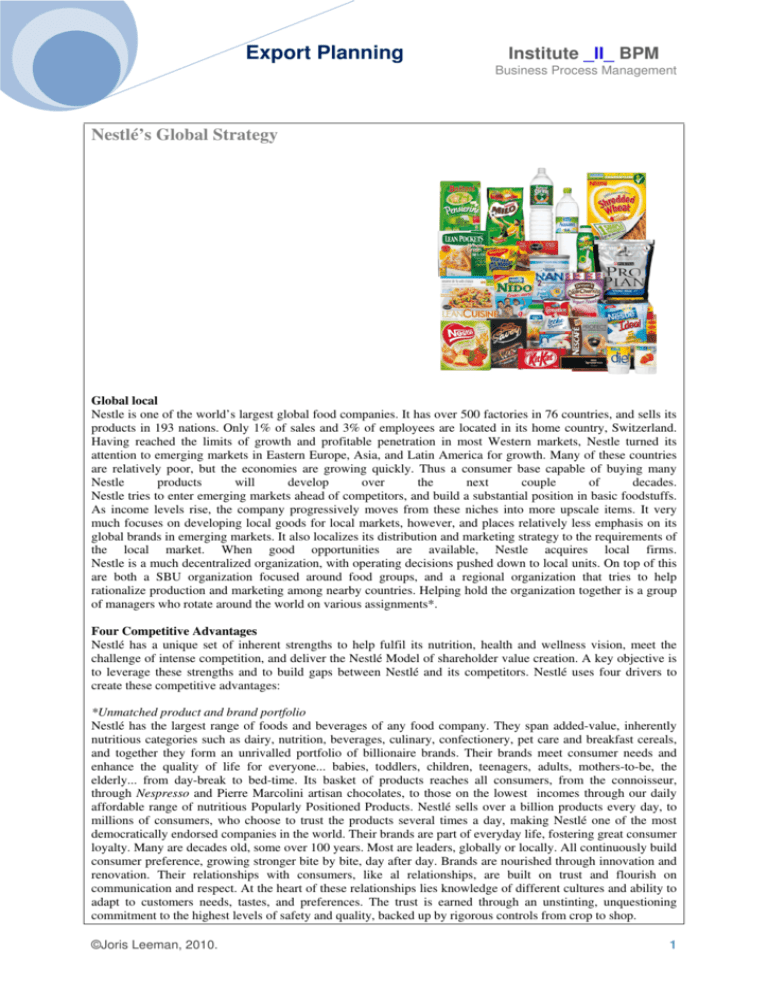
Export Planning Institute _II_ BPM Business Process Management Nestlé’s Global Strategy Global local Nestle is one of the world’s largest global food companies. It has over 500 factories in 76 countries, and sells its products in 193 nations. Only 1% of sales and 3% of employees are located in its home country, Switzerland. Having reached the limits of growth and profitable penetration in most Western markets, Nestle turned its attention to emerging markets in Eastern Europe, Asia, and Latin America for growth. Many of these countries are relatively poor, but the economies are growing quickly. Thus a consumer base capable of buying many Nestle products will develop over the next couple of decades. Nestle tries to enter emerging markets ahead of competitors, and build a substantial position in basic foodstuffs. As income levels rise, the company progressively moves from these niches into more upscale items. It very much focuses on developing local goods for local markets, however, and places relatively less emphasis on its global brands in emerging markets. It also localizes its distribution and marketing strategy to the requirements of the local market. When good opportunities are available, Nestle acquires local firms. Nestle is a much decentralized organization, with operating decisions pushed down to local units. On top of this are both a SBU organization focused around food groups, and a regional organization that tries to help rationalize production and marketing among nearby countries. Helping hold the organization together is a group of managers who rotate around the world on various assignments*. Four Competitive Advantages Nestlé has a unique set of inherent strengths to help fulfil its nutrition, health and wellness vision, meet the challenge of intense competition, and deliver the Nestlé Model of shareholder value creation. A key objective is to leverage these strengths and to build gaps between Nestlé and its competitors. Nestlé uses four drivers to create these competitive advantages: *Unmatched product and brand portfolio Nestlé has the largest range of foods and beverages of any food company. They span added-value, inherently nutritious categories such as dairy, nutrition, beverages, culinary, confectionery, pet care and breakfast cereals, and together they form an unrivalled portfolio of billionaire brands. Their brands meet consumer needs and enhance the quality of life for everyone... babies, toddlers, children, teenagers, adults, mothers-to-be, the elderly... from day-break to bed-time. Its basket of products reaches all consumers, from the connoisseur, through Nespresso and Pierre Marcolini artisan chocolates, to those on the lowest incomes through our daily affordable range of nutritious Popularly Positioned Products. Nestlé sells over a billion products every day, to millions of consumers, who choose to trust the products several times a day, making Nestlé one of the most democratically endorsed companies in the world. Their brands are part of everyday life, fostering great consumer loyalty. Many are decades old, some over 100 years. Most are leaders, globally or locally. All continuously build consumer preference, growing stronger bite by bite, day after day. Brands are nourished through innovation and renovation. Their relationships with consumers, like al relationships, are built on trust and flourish on communication and respect. At the heart of these relationships lies knowledge of different cultures and ability to adapt to customers needs, tastes, and preferences. The trust is earned through an unstinting, unquestioning commitment to the highest levels of safety and quality, backed up by rigorous controls from crop to shop. ©Joris Leeman, 2010. 1 Export Planning Institute _II_ BPM Business Process Management *Unmatched R&D capability Nestlé has a long nutritional science heritage. The first product to carry the name of the company’s founder, Henri Nestlé, was an innovative infant cereal developed to nurture babies, giving them a healthy start in life. His ambition even in 1866 was to market his product and its benefits across the world. Since then, Nestlé has gone from strength to strength but always following in the footsteps of Henri Nestlé, ensuring its products meet consumer needs by inventive research to provide positive benefits for millions of people. For example, Nestlé’s Nutrition business is pioneering new ground in specialised nutrition by developing and delivering innovative, effective, scientifically proven products with functional benefits. For babies, the development of Infant Formulas with probiotics which can support the immune system is one example. For the elderly, they are investigating the role of nutrition in maintaining mobility and independence during old age. Nestlé spent CHF 2 billion on R&D in 2008 – more than any other food company. They have about 5000 people from over 50 countries working in our R&D network of Research Centres, Product Technology Centres and Application Groups around the world. This is greatly expanded by our open innovation that taps into some 300 external research institutions, including universities, start-ups, and key suppliers, as well as with own venture funds. Consumer insights and Nutrition, Health and Wellness benefits are the starting points for their R&D and the fuel for its innovation pipeline across all categories. But R&D extends beyond the product itself, developing new technologies, for example for packaging and vending machines, and researching specific areas such as ingredient and product safety, sensory quality and metabolics. *Unmatched geographic presence The competitive advantage created by its unmatched geographic presence, with products marketed in about 130 countries, is not simply a global spread, as many companies can claim a similar reach, nor is it just its scale, with over CHF 35 billion of sales in emerging countries. It is the fact that they have been in most countries for many decades, many for over a hundred years. It means that their products have been enjoyed by generations of families, that many of their brands are perceived as local by its consumers, and that they have an unmatched reputation for quality, taste and nutrition. It also means that they have had plenty of time to learn and understand local cultures and habits, and benefit local economies and communities. A significant part of that benefit comes from their manufacturing asset base, with 456 factories located all over the world. These factories represent a long-term commitment to contribute to economic prosperity in the communities where they are present through investment, profitable growth and increasing employment opportunities. Although their products are available all over the world, Nestlé does not believe in a standard worldwide taste. They go to great lengths to adapt their products to local tastes. Although Maggi is a global brand, its soup products are very different, for example, in Poland from Indonesia. Nescafé, meanwhile, has over 200 formulations around the world. Although Nestlé is a global giant and the world’s largest food and beverage company, it is a closely knit network of local companies, each with sufficient scale to leverage its own synergies, yet agile and nimble in spotting opportunities and tackling challenges. Nestlé’s principle is “centralise what we can, but decentralise as much as possible”. *People, culture, values and attitude Nestlé emphasis on both leveraging our scale and being agile in our approach to business opportunities and challenges is part of their cultural DNA. Their people thrive within this environment. Their strengths, talent and energy are the life blood of our organisation. This culture places a high value on long-term thinking, integrity, mutual respect, pragmatism, openness to diversity and a passion for quality and for pleasing its consumers. Nestlé formulates it as follows: “We are highly disciplined. We are aligned on our vision. We have the tools, best practices and skills to allow us to translate vision to action. We respond to challenges thoughtfully and with the benefit of experience. We are never satisfied with the status quo, and are constantly challenging ourselves for greater speed, efficiency, learning and achievement. “ Source: case text composed by Joris Leeman, Oct. 12, 2009. *http://www.oppapers.com/essays/NestleCase/192942, ** Nestlé Management Report 2008. ©Joris Leeman, 2010. 2
